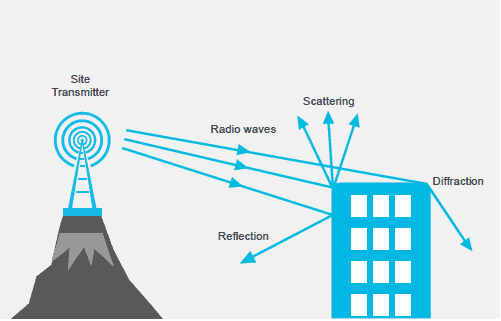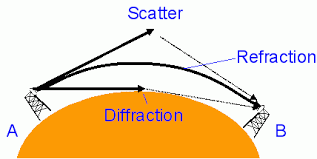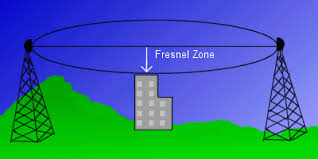Posted By: technopediasite

Reflection
Reflection can be defined as the abrupt change in direction of a wave front as it strikes a
dissimilar media, which has a smooth surface and is much larger than the wave itself.

Reflection may be specular (i.e., mirrorlike) or diffuse (i.e., not retaining the image,
only the energy) according to the nature of the interface.
Depending on the item reflecting the wave, the reflected wave may be inverted or
shifted in phase. This inverted, or phase-shifted, wave can cause interference at a
receiver that can see both reflected and direct waves.
Because the direct wave can be reflected off many objects, the signals arriving at
the receiver can be at different times and phases, partially canceling each other,
which is known as multipath fading.
Refraction
Refraction is the abrupt change in direction as well as the absorption of a wave front as it
strikes a dissimilar media of different densities.

Scattering
Scattering is the phenomenon in which the direction, frequency, or polarization of the wave is changed when the wave encounters rough surfaces or objects smaller than the wave itself. Scattering also can be a result of the wave’s interaction with materials at the atomic or
molecular level.
Scattering results in many reflected and disordered waves, which can weaken or
even cancel the main wave front.
Scattering also can be the result of atmospheric changes due to heavy rain or dust.

Diffraction
Diffraction is the deviation of an electromagnetic wave front from the predicted path when it
strikes a surface with sharp corners or an object with a rough surface. The waves are bent
around the object, thus changing the wave front’s path.

Absorption
Absorption is the dissipation of an electromagnetic wave when it strikes a medium that does
not allow the wave to be reflected, refracted, or diffracted.

Ducting
On rare occasions, usually when temperature inversions occur, the atmosphere may become stratified with a few layers of varying index of refraction. A microwave signal can become trapped between these layers, causing it to be carried away from its intended destination (the remote receiver). Ducting is usually quite deep and can last many hours. It typically occurs on hot, humid summer nights when there is no wind to stir the atmosphere.
Earth Curvature (Earth Bulge)
Earth bulge is the curvature of the Earth over a given distance. For LOS radio operations, it
must be considered for those radio shots exceeding 11.3 km (7 mi).
Antenna height calculations need to be considered for the Earth’s bulge for shots more than
11.3 km (7 mi), as the Earth’s bulge can affect the Fresnel zone.
The k-factor is a calculation used in both tropospheric and ionospheric propagation:
• In tropospheric radio propagation, the ratio of the effective Earth radius to the actual
Earth radius. The k-factor is approximately 4/3.
• In ionospheric radio propagation, a correction factor that is applied in calculations related
to curved layers and is a function of distance and the real height of ionospheric reflection.
Fresnel Zones
Fresnel zones are a series of concentric ellipsoids surrounding the path.
The first Fresnel zone is the surface containing every point for which the sum of the distances from that point to the two ends of the path is exactly one-half wavelength longer than the direct end-to-end path.
Each of the other Fresnel zones (“nth” Fresnel zone) is defined in the same way as the first
zone, except the difference is “n-half” (n/2) wavelengths.
The first Fresnel zone is a nominal unit used to measure certain distances (e.g., path
clearances) in terms of their effect on the frequency involved, rather than in terms of meters
(feet). The other zones also are important under certain conditions (e.g., highly reflective
paths).
Clearance requirements expressed in Fresnel zones apply to the sides and top of the path as well as to the bottom. A cross section of the zones at any point along the path shows a series of concentric circles completely surrounding the path.


Reflection
Reflection can be defined as the abrupt change in direction of a wave front as it strikes a
dissimilar media, which has a smooth surface and is much larger than the wave itself.

Reflection may be specular (i.e., mirrorlike) or diffuse (i.e., not retaining the image,
only the energy) according to the nature of the interface.
Depending on the item reflecting the wave, the reflected wave may be inverted or
shifted in phase. This inverted, or phase-shifted, wave can cause interference at a
receiver that can see both reflected and direct waves.
Because the direct wave can be reflected off many objects, the signals arriving at
the receiver can be at different times and phases, partially canceling each other,
which is known as multipath fading.
Refraction
Refraction is the abrupt change in direction as well as the absorption of a wave front as it
strikes a dissimilar media of different densities.
Scattering
Scattering is the phenomenon in which the direction, frequency, or polarization of the wave is changed when the wave encounters rough surfaces or objects smaller than the wave itself. Scattering also can be a result of the wave’s interaction with materials at the atomic or
molecular level.
Scattering results in many reflected and disordered waves, which can weaken or
even cancel the main wave front.
Scattering also can be the result of atmospheric changes due to heavy rain or dust.
Diffraction
Diffraction is the deviation of an electromagnetic wave front from the predicted path when it
strikes a surface with sharp corners or an object with a rough surface. The waves are bent
around the object, thus changing the wave front’s path.
Absorption
Absorption is the dissipation of an electromagnetic wave when it strikes a medium that does
not allow the wave to be reflected, refracted, or diffracted.
Ducting
On rare occasions, usually when temperature inversions occur, the atmosphere may become stratified with a few layers of varying index of refraction. A microwave signal can become trapped between these layers, causing it to be carried away from its intended destination (the remote receiver). Ducting is usually quite deep and can last many hours. It typically occurs on hot, humid summer nights when there is no wind to stir the atmosphere.
Earth Curvature (Earth Bulge)
Earth bulge is the curvature of the Earth over a given distance. For LOS radio operations, it
must be considered for those radio shots exceeding 11.3 km (7 mi).
Antenna height calculations need to be considered for the Earth’s bulge for shots more than
11.3 km (7 mi), as the Earth’s bulge can affect the Fresnel zone.
The k-factor is a calculation used in both tropospheric and ionospheric propagation:
• In tropospheric radio propagation, the ratio of the effective Earth radius to the actual
Earth radius. The k-factor is approximately 4/3.
• In ionospheric radio propagation, a correction factor that is applied in calculations related
to curved layers and is a function of distance and the real height of ionospheric reflection.
Fresnel Zones
Fresnel zones are a series of concentric ellipsoids surrounding the path.
The first Fresnel zone is the surface containing every point for which the sum of the distances from that point to the two ends of the path is exactly one-half wavelength longer than the direct end-to-end path.
Each of the other Fresnel zones (“nth” Fresnel zone) is defined in the same way as the first
zone, except the difference is “n-half” (n/2) wavelengths.
The first Fresnel zone is a nominal unit used to measure certain distances (e.g., path
clearances) in terms of their effect on the frequency involved, rather than in terms of meters
(feet). The other zones also are important under certain conditions (e.g., highly reflective
paths).
Clearance requirements expressed in Fresnel zones apply to the sides and top of the path as well as to the bottom. A cross section of the zones at any point along the path shows a series of concentric circles completely surrounding the path.




1 Comments
You have given great content here. duct cleaning service Chicago I am glad to discover this post as I found lots of valuable data in your article. Thanks for sharing an article like this.
ReplyDelete